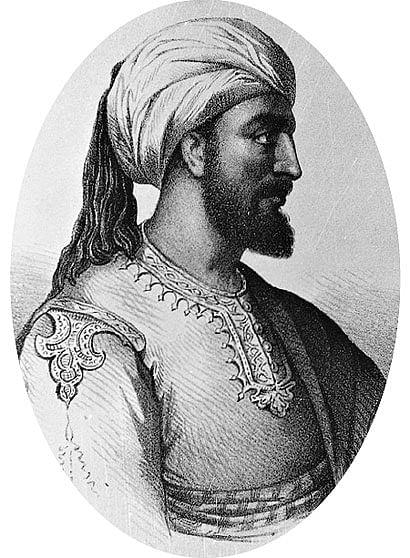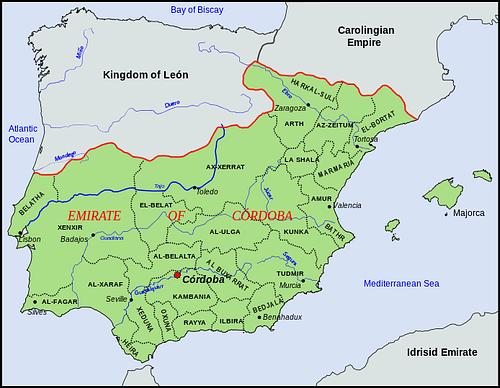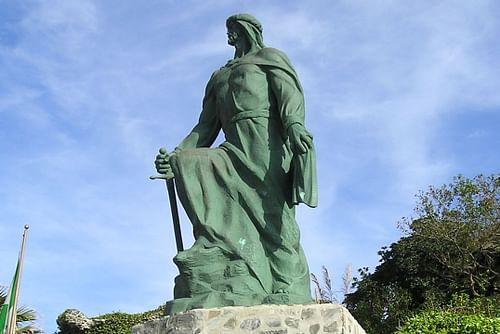Abd al-Rahman was the founder of the Emirate of Cordoba and ruled as Abd al-Rahman I from 756-788 CE. As one of the lone survivors of the Umayyad Dynasty after the Abbasids defeated the Umayyad Caliphate, Abd al-Rahman bridged the Umayyad Caliphate and the Umayyad Emirate of Cordoba in Spain. Although he did not start Muslim rule in Spain, Abd al-Rahman established it as a vibrant, independent, and long-lasting political and cultural power.
The Rise & Fall of the Umayyad Caliphate
The Umayyad Dynasty had established itself as the leader of Islam in 661 CE under Muawiya, the governor of Islamic Syria. Syria and Syrian Arabs became the power base for the Umayyads during their nearly century-long rule of the Islamic world. From their capital at Damascus, the Umayyads expanded their empire to reach the borders of China in the east and into Europe in the west. They launched assaults on the Byzantine capital at Constantinople twice and skirmished with the Tang Empire of China and the Franks.
In short, the Umayyads established the most powerful and wealthy empire of their day. Born into this glittering and powerful Umayyad court was Abd al-Rahman, the grandson of Caliph Hisham (r. 724-743 CE). But the opulent court where Abd al-Rahman was raised, and likely planned to live the rest of his life, was snatched from him in the fires of revolution when he was still a teenager. The Umayyads had focused on Syria and the Arabs almost to the exclusion of other peoples inside the empire, and this now came back to haunt them. In the border province of Khurasan, the local leader Abu Muslim declared a revolt against Umayyad authority in 747 CE. This revolution advanced on the core of the empire and defeated the last Umayyad caliph in the Battle of the Zab in 750 CE. The Abbasid Caliphate was now in control.
The Refugee Prince
The aftermath was a purge of all things Umayyad. The Abbasids sent riders out to track down and slaughter every last Umayyad descendant. Practically the lone survivor of this bloodbath was Abd al-Rahman. Amidst the horror of seeing his entire family systematically killed and his life ripped apart, the young refugee prince initially fled with a few of his close family members towards the Euphrates River. Once discovered, he had to abandon his relatives, including his infant son, Sulayman, and flee further afield. Abd al-Rahman spent the next few years traveling only with a Greek freedman, Bedr. Largely going incognito, they headed down through Palestine and across Muslim North Africa, looking anywhere for sanctuary. The ruler of Islamic Ifriqiya, roughly modern Tunisia, resisted Abbasid domination and initially invited the surviving Umayyads to join him, but, fearing that the Umayyads would overthrow him, later turned on the Umayyads including Abd al-Rahman. Betrayed, the refugee continued his journey west.

Abd al-Rahman received some assistance from the Berber tribes of North Africa to which his mother had belonged. However, the deciding moment of his life would take him out of Africa and into Europe. When he arrived at the Straits of Gibraltar in 755 CE, about as far from the Abbasids as possible, he sent Bedr into Spain to see if it could become his new home.
Meanwhile in Spain
The forces of Islam had invaded the weakened Visigoth kingdom in Spain back in 711 CE and quickly conquered most of the Iberian Peninsula, including the Visigoth capital of Toledo. Some of the Christians fled and carved out a poor rump state in the far north of the peninsula, which would be engaged in a life and death struggle with the Muslims for control of the Iberian Peninsula for the next seven centuries. The Frankish army under Charles Martel finally halted Muslim expansion north into Europe at the Battle of Poitiers in 732 CE. After the conquest of Visigoth Spain, the Umayyads organized the territory into an administrative unit that became known as Al-Andalus. The Umayyads sent governors to rule the territory in their name. The last of these governors, Yusuf al-Fihri, arrived in Spain in 747 CE.
But despite the nominal leadership of the governor, Al-Andalus was in chaos. A massive Berber revolt in the 740s CE had led to the eruption of simmering ethnic tensions between Berber and Syrian troops. Al-Fihri, leading mostly Yemeni Arab troops, was locked in combat with one of his former viziers, al-Sumayl, who was supported by Syrian Arab soldiers in Zaragoza.

Emir of Cordoba
Into this divided peninsula strode Abd al-Rahman, who landed in the Spanish city of Almuñécar in 755 CE. Over this half-century of rule, Spain had been provided with regular injections of Syrian Arab troops. These Syrians, from the former base of power of the Umayyads, remained loyal to the Umayyad Dynasty and its memory. Inspired by the Umayyad name, and probably tired of the infighting in Al-Andalus, people rallied to Abd al-Rahman's banner. His forces took Malaga and Seville, and then marched on the provincial capital of Al-Andalus, Cordoba, in 756 CE. Below the walls of the city, Abd al-Rahman defeated the forces of Al-Fihri. Al-Fihri fled to Toledo to raise another army, but Abd al-Rahman's reputation had grown to such an extent that he did not even need to chase after Al-Fihri himself. Soon Al-Fihri's head ended up on his doorstep in Cordoba, and al-Sumayl was captured and locked in a Cordoba jail shortly thereafter. With most major cities in southern Spain under his control, Abd al-Rahman declared himself the Emir of Cordoba in 756 CE.
Himself a victim of the Abbasids, Abd al-Rahman's new emirate became a haven for those political and religious dissenters suffering from Abbasid persecution. Amongst the influx of refugees was Sulayman, Abd al-Rahman's son whom he had had to leave back on the banks of the Euphrates when fleeing from the Abbasids six years before. Here, at the edge of the known world, was the first breakaway Muslim state in history. Abd al-Rahman promoted his few remaining Umayyad family members to leading positions in the emirate, and soon it was an Umayyad Caliphate in miniature.
The new Abbasid caliph, Al-Mansur (r. 754-775 CE), was understandably outraged by this young upstart breaking off part of his empire. This rage was only heightened by the fact that Al-Mansur had inherited all of the anti-Umayyad venom of his Abbasid predecessor. Al-Mansur appointed a new governor of Africa, Al-Ala, to defeat Abd al-Rahman's upstart emirate. In 763 CE, Al-Ala landed an Abbasid force in modern-day Portugal. Al-Ala's superior force managed to besiege Abd al-Rahman in the city of Carmona and, with vastly superior numbers, it seemed that the Emirate of Cordoba would be short-lived. However, with starvation imminent if action was not taken soon, Abd al-Rahman led his remaining troops out of Carmona and fell on the surprised Abbasid soldiers. The heads of his dead enemies were packed in salt and sent back to Al-Mansur, who, albeit probably reluctantly, admitted that he was glad the Mediterranean Sea separated him from the Umayyad.
Looking for Revenge, Fighting for Control
Although he had defeated the Abbasids in Spain, Abd al-Rahman yearned to take the fight to the Abbasids back in his homeland in Syria. He did not just want to carve out a new home for himself, but to destroy the Abbasids like they had devastated his own family. But Abd al-Rahman would never get the chance. For the rest of his life, he was bogged down trying to bring the rest of Muslim Spain into his Emirate of Cordoba. Revolts were common, and Abd al-Rahman had to fight for practically every city as he advanced north.

Of particular difficulty was the city of Zaragoza in northeastern Spain. Zaragoza was Muslim but had been semi-autonomous since Al-Fihri's governorship. It and the surrounding land north of the Ebro River had resisted being incorporated into the Emirate of Cordoba. In 777 CE, Zaragoza complicated the situation in Spain by calling for aid from none other than the King of the Franks, Charles I, known to history as Charlemagne (r. 768-814 CE). Charlemagne did not just lead a small detachment but his entire army across the Pyrenees and into Spain. The rebel Muslim city of Barcelona opened its gates to Charlemagne, but Zaragoza, the very city that had invited Charlemagne in the first place, realized that once Charlemagne gained a foothold, he would not be keen to leave. Finding Zaragoza's gates closed to him, Charlemagne retreated through the pass of Roncesvalles in 778 CE, but his rearguard was massacred in an ambush by local Basques. Roncesvalles was the lone defeat in Charlemagne's long military career, and inspired the legendary Song of Roland.
With Charlemagne now gone, Zaragoza remained a thorn in Abd al-Rahman's side. He gained nominal control of the city by bribing a local notable to kill the leader of Zaragoza in exchange for a governorship over the entire region. When this new governor started to gain a taste for independence, Abd al-Rahman had the military strength to attack directly this time. In 783 CE, Zaragoza fell to Umayyad forces. At last, all of Muslim Spain was firmly in the hands of Abd al-Rahman.
Legacy of Abd al-Rahman
In addition to founding the Emirate of Cordoba, Abd al-Rahman was a conscientious ruler. He repaired and built roads, bridges, and aqueducts. He established a centralized merit-based bureaucracy to administer the emirate. To better establish lasting Umayyad control over the peninsula, he instituted an intelligence service and a standing army. Abd al-Rahman also continued his forefathers' practice of religious tolerance. All of these elements combined to create a strong foundation for future Umayyad prosperity, which in part explains the longevity of the Umayyad Dynasty in Spain, which lasted until 1031 CE.
Perhaps Abd al-Rahman's greatest legacy, however, was none of these governmental organizations, but the Great Mosque of Cordoba, founded in the mid 780s CE, which brought together elements of Spanish culture up to then. The mosque was built on the site of an old Visigoth basilica. It is a unique fusion between the style of mosques in Damascus, Abd al-Rahman's birthplace, and elements of Christian basilicas. It also utilized material from Visigoth- and Roman-era buildings for pillars and building supplies. Although this mosque was further expanded by Abd al-Rahman's successors, the core of the mosque, including the signature red stripes and horseshoe arches, were in Abd al-Rahman's original contribution.
When Abd al-Rahman died around 788 CE, the Emirate of Cordoba passed to his son Hisham I (r. 788-796 CE). While he had not managed to completely avenge the murder of his Umayyad brethren, surviving as a refugee to found an independent Muslim emirate separate from the Abbasid Caliphate was no mean feat. The fact that the Umayyads would survive in Spain until 1031 CE, and that Muslim rule in Spain would last until 1492 CE, is a testament to Abd al-Rahman's life and herculean efforts.
